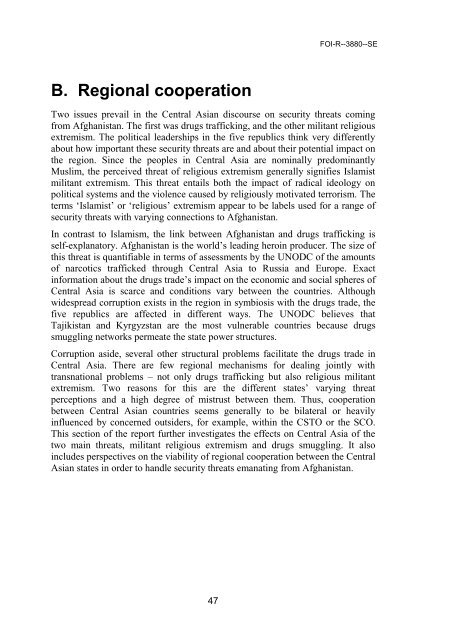foir_3880
foir_3880
foir_3880
Create successful ePaper yourself
Turn your PDF publications into a flip-book with our unique Google optimized e-Paper software.
FOI-R--<strong>3880</strong>--SE<br />
B. Regional cooperation<br />
Two issues prevail in the Central Asian discourse on security threats coming<br />
from Afghanistan. The first was drugs trafficking, and the other militant religious<br />
extremism. The political leaderships in the five republics think very differently<br />
about how important these security threats are and about their potential impact on<br />
the region. Since the peoples in Central Asia are nominally predominantly<br />
Muslim, the perceived threat of religious extremism generally signifies Islamist<br />
militant extremism. This threat entails both the impact of radical ideology on<br />
political systems and the violence caused by religiously motivated terrorism. The<br />
terms ‘Islamist’ or ‘religious’ extremism appear to be labels used for a range of<br />
security threats with varying connections to Afghanistan.<br />
In contrast to Islamism, the link between Afghanistan and drugs trafficking is<br />
self-explanatory. Afghanistan is the world’s leading heroin producer. The size of<br />
this threat is quantifiable in terms of assessments by the UNODC of the amounts<br />
of narcotics trafficked through Central Asia to Russia and Europe. Exact<br />
information about the drugs trade’s impact on the economic and social spheres of<br />
Central Asia is scarce and conditions vary between the countries. Although<br />
widespread corruption exists in the region in symbiosis with the drugs trade, the<br />
five republics are affected in different ways. The UNODC believes that<br />
Tajikistan and Kyrgyzstan are the most vulnerable countries because drugs<br />
smuggling networks permeate the state power structures.<br />
Corruption aside, several other structural problems facilitate the drugs trade in<br />
Central Asia. There are few regional mechanisms for dealing jointly with<br />
transnational problems – not only drugs trafficking but also religious militant<br />
extremism. Two reasons for this are the different states’ varying threat<br />
perceptions and a high degree of mistrust between them. Thus, cooperation<br />
between Central Asian countries seems generally to be bilateral or heavily<br />
influenced by concerned outsiders, for example, within the CSTO or the SCO.<br />
This section of the report further investigates the effects on Central Asia of the<br />
two main threats, militant religious extremism and drugs smuggling. It also<br />
includes perspectives on the viability of regional cooperation between the Central<br />
Asian states in order to handle security threats emanating from Afghanistan.<br />
47


